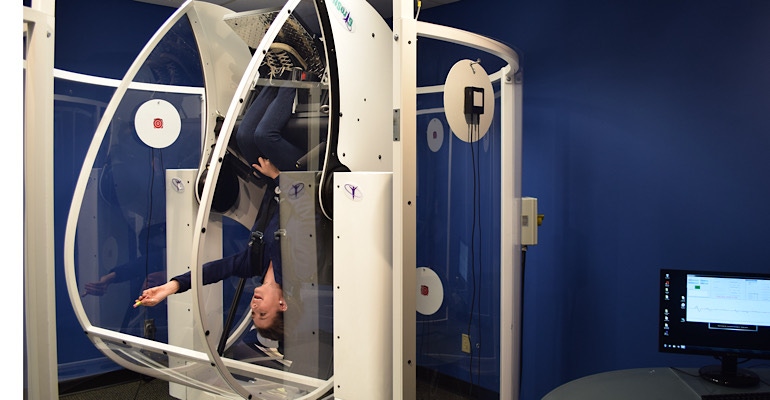Daughter Serves as Inspiration for Inventor’s Balance Disorder Treatment Device
Kevin Maher, CEO of UltraThera, came up with the idea for, GyroStim, a computer-controlled, multi-axis rotational chair. The technology has been greenlit by FDA.
September 14, 2022

Clinicians now have a new and more effective medical device for treating balance disorders. The device is automated, provides unprecedented control of therapy, is accessible for millions of senior citizens and others with a severe balance disorder, and improves balance an average of four times faster than the current standard of care, according to the company.
“The sensory-motor system allows humans to perceive their world, process their world, and react to their world, and the vestibular system is a huge contributor to that system,” said Kevin Maher, inventor of GyroStim and CEO of UltraThera, in an interview with MD+DI.
He said many people have dysfunction within their sensory-motor system resulting from a head injury, illness, or advanced age which can lead to balance disorders and an increased risk of falling, and that can lead to a whole host of other medical problems, including fatalities.
The standard of care for balance disorders has been vestibular rehabilitation therapy (VRT). It typically involves months of physical exercises to improve strength and to rehabilitate the sensory-motor system. However, many people are not physically capable of engaging in the exercises.
“It's a catch-22,” Maher said. “You must have a functioning balance system to improve your balance system. And there are millions of people out there that, because of an injury or other conditions, they're not capable of engaging in VRT, leaving them with reduced quality of life and at a high risk of falling and getting injured.”
That situation is personal for Maher. His young daughter, Mackenzie, needed vestibular therapy due to her diagnosis of cerebral palsy. Seeing firsthand how difficult VRT was for her to engage in and for her caregivers to administer, he wondered if the process could be automated. With his background in semiconductor manufacturing and robotics, he came up with the idea for a computer-controlled, multi-axis rotational chair.
And that is how GyroStim came about.
“My life used to be all about moving computer chips with robotics, now it’s all about moving people with robotics,” Maher said. “The rotational chair is controlled by software that has preprogrammed motion profiles that make it easy and efficient for a clinician to administer specific and precisely controlled intensities of motion-induced vestibular stimulation,” he explained.
“The software has capabilities for collecting, monitoring, and displaying the patient’s quantitative and qualitative responses for each run,” he said. “And that adds significant clinical value because it helps clinicians with making informed decisions for individualizing and optimizing the treatment and for monitoring and preventing the patient from being over stimulated.”
GyroStim offers a wide range of capabilities for motion-induced vestibular stimulation intensities ranging from 1 RPM to 30 RPM and all RPMs in-between. “GyroStim provides clinicians with absolute control over all the motion parameters involved with generating the therapeutic stimulation, and this is a critical aspect of treatment that manual VRT simply cannot provide. This allows clinicians to administer quantifiable amounts of vestibular stimulation with significantly improved control, safety, intensity, replication, precision, comfort, and with confidence,” Maher said.
For people confined to a wheelchair, GyroStim provides accessibility via an automated patient transfer system. “Making this therapy accessible for people suffering with severe mobility challenges was the main inspiration for developing GyroStim in the first place,” Maher said.
GyroStim’s FDA clearance and formal entry into the medical device market couldn’t come at a better time. According to the CDC, falls have become the leading cause of injury and injury death for adults over 65 in America (Centers for Disease Control and Prevention, 2020). Falls not only cause a tremendous amount of human suffering and reduced quality of life, they also cause a huge strain on CMS with costs of about $50 billion each year, and that number continues to climb (Florence, 2018).
“Finally, we can market GyroStim for what it is,” Maher concluded. “A breakthrough medical device for treating balance disorders, with the potential for improving the quality of life for millions of people and saving the healthcare system billions of dollars.”
GyroStim systems have been installed in neurology clinics, sports medicine clinics, aerospace medical labs, and universities in eight countries around the world.
About the Author(s)
You May Also Like




